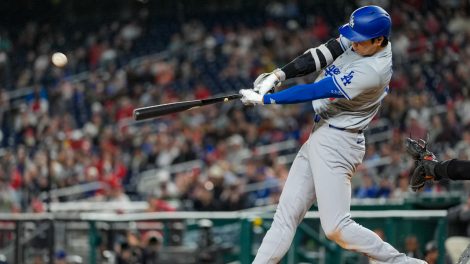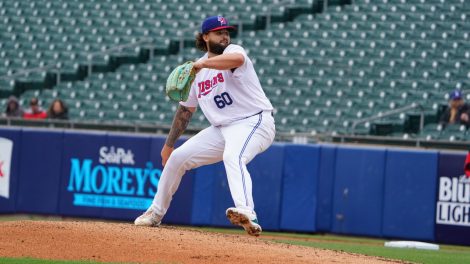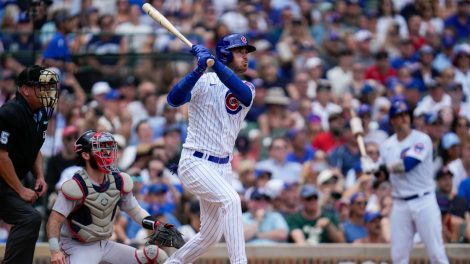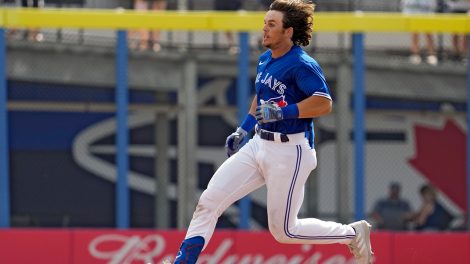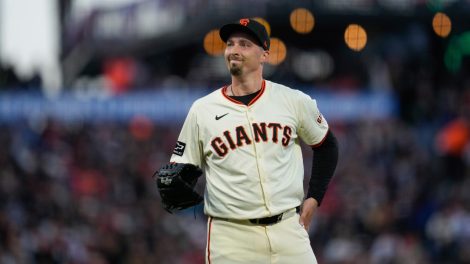DUNEDIN, Fla. — There was a reason Max Pentecost was a first-round pick in the 2014 MLB draft, selected 11th overall by the Toronto Blue Jays. A reason the 2013 Cape Cod League MVP was then given a $2.9 million bonus to sign with the club. A reason evaluators at the time called him the best pure catcher in the draft, a terrific all-around athlete who had a great chance to stick at the position and reach the majors.
But those reasons get a little lost when you look at what Pentecost has gone through between then and now. First, there was a shoulder surgery after the 2014 season. Then a second shoulder surgery in spring of 2015. And yet another that fall, completing a trio of operations that kept Pentecost off a baseball diamond for nearly two full years.
Now 24, with only 171 professional games under his belt, Pentecost is trying to show everyone he’s still the player who was so highly regarded in the 2014 draft. And he’s trying show up in the majors better late than never.
“It’s by no means ideal,” Pentecost says of his career track this August in Dunedin. “But at the same time, it doesn’t ever let you take anything for granted. I haven’t been able to sit back and just say, ‘Man, this is easy.’ I’ve never enjoyed that. I’ve had to work pretty hard for everything.”
The Blue Jays sent Pentecost to high-A Dunedin this year, where he hit .276/.332/.434 over 71 games, chipping in nine homers and 14 doubles. That built on a very strong 2016, when he returned from his extended absence and hit .302/.361/.486 over 74 games split between mid- and high-A. Even with all he’s had to overcome, Pentecost has never forgotten how to hit.
“He has a lot of ability,” says Dunedin hitting coach Corey Hart. “His hands are as fast as anybody you’re going to see. He’s got power. He’s an exciting player, for sure. I think without the injuries, if he never had a surgery, he’d be knocking on the door of the big leagues right now — if not already there.”
[snippet id=3305549]
The big test this year came in the field. After playing every game in 2016 as a designated hitter, Pentecost split his time this season between DH (30 games), first base (22 games) and his preferred position, catcher (19 games), in order to lessen the physical toll he’d withstand in his second season back from surgery.
He’ll go to the Arizona Fall League this October. That positional split will likely continue, ahead of 2018, when the plan is for Pentecost to play primarily behind the plate.
“I’m sure it’s frustrating for him. It’s tough to go from behind the plate, where you’re involved in every pitch, to not being as involved,” Dunedin manager John Schneider says. “But with his injury history, we’re just being really careful. Obviously, with the bigger picture being him playing in Toronto someday. Because when he’s healthy and behind the plate, he can be a real difference maker.”
Of course, Pentecost loves catching. He’d do it every day if they’d let him. There’s something about the control of it, the effect you can have on every pitch, every decisive moment in the game. For thoughtful, engaged athletes like Pentecost who naturally gravitate towards leadership roles, it’s the perfect position.
“There’s times when you’re out there at first base and you feel like you haven’t done anything in two innings,” he says. “And it sucks not having control over the game. Because I just love that battle between pitcher and hitter. I love being a part of that.”
In order to keep his mind moving when he plays first or DH, Pentecost carefully watches opposition hitters, looking for cues in their swings and trying to pick up tendencies. He game calls in his head. He then carries that information with him when he’s behind the plate, and finds he has an entirely new perspective on what hitters are trying to do, and how best to attack them.
“It’s pretty beneficial, because from the field you get to see the hitter from a completely different point of view,” he says. “You pick up different things, and then that translates when you’re catching.”
And while it’s frustrating to not catch as often as he’d like, Pentecost does see the benefit of having first base experience.
MLB teams are increasingly looking for versatile players who can serve capably in more than one position. And for catchers with strong hit tools like Pentecost, first base can be a useful option to keep their bat in the lineup while lessening the physical stress one withstands behind the plate. Players like Buster Posey, Alex Avila and Brian McCann have shown just how valuable that versatility can be over the last several years at the major-league level.
“It gives me a little more value in the future,” Pentecost says. “I think that’s kind of the reason they wanted me to work at first, anyway. So, I’ll take it and run with it.”
Of course, those who see him play every day say Pentecost is at his best when he’s catching. His bat certainly plays well there — not many catchers can flirt with an .800 OPS as Pentecost has in his minor-league career. But his coaches love his defensive ability, as well.
[relatedlinks]
“He’s a great receiver,” says Schneider, a former catcher himself. “He’s got soft hands. He receives the low strike probably better than anyone we have in the organization. Great arm. He blocks well. Really, it’s everything you look for in a catcher, from presence to receiving, blocking, throwing — he’s got it all.”
Most importantly, Pentecost hasn’t had any issues with his shoulder this season, which is a testament to the rigorous work he puts in to keeping his arm healthy. Before games, he goes through a long routine to loosen the shoulder up and make sure its prepared for the stresses it’ll experience over nine innings. Afterwards, he works through a strengthening session so that it can bounce back and feel strong the next day.
Part of Pentecost’s challenge now is merely making up for lost time. He needs experience just like any other prospect, and after missing as much time as he did, he’s scrambling to play catch up.
But the Blue Jays will have to add him to their 40-man roster this winter or risk losing him to another organization through the Rule 5 draft. That could expedite Pentecost’s path to the majors, or at least encourage the Blue Jays to test him in 2018 at higher minor-league levels to see just what they have in him.
Either way, Pentecost is just relieved to be past his physical struggles, and excited to get back to being a baseball player again. Just a guy who comes to the ballpark every day and puts in the work. In a career that has been anything but ideal, a return to the normalcy of simply honing his skills every day felt pretty good.
“My main goal this year was to get back behind the plate, see how the body was going to adjust. And it felt so great getting back there,” he says. “Just getting to work on stuff like I used to was so great. Even offensively. I hadn’t really gotten to make adjustments and work on things in a long time. And then things start to click a little and its cool to see the progress.
“You know, over the season, just like any player, you go up and down. And you’ve got to figure out how to limit those downs, from game to game, year to year. So, that’s what we’re trying to do. And I think it’s going pretty well.”


